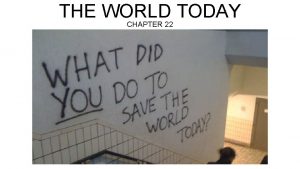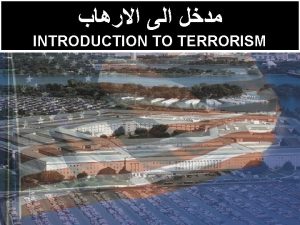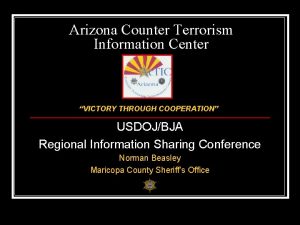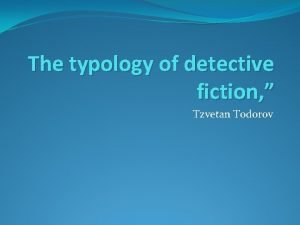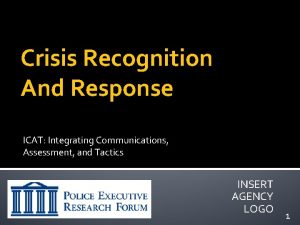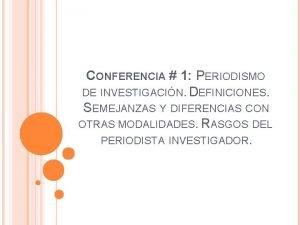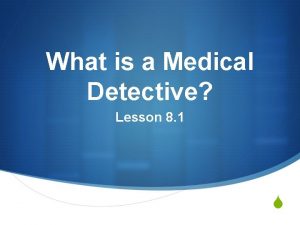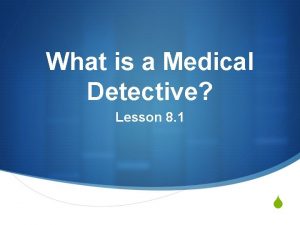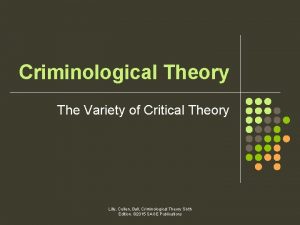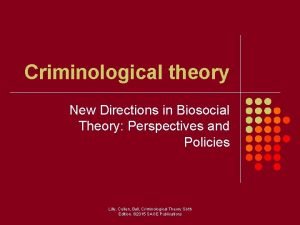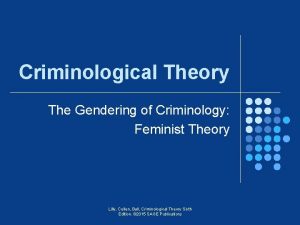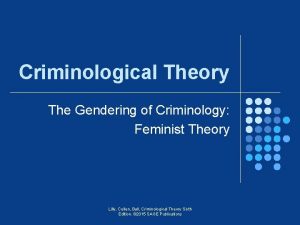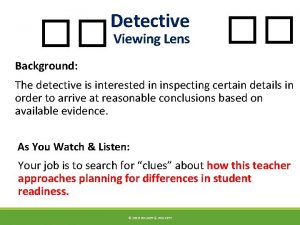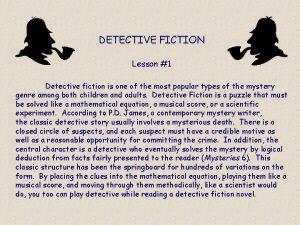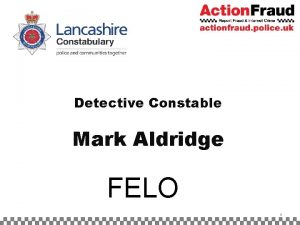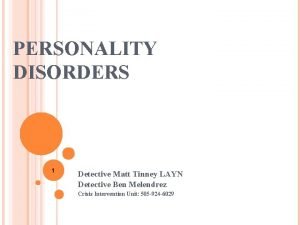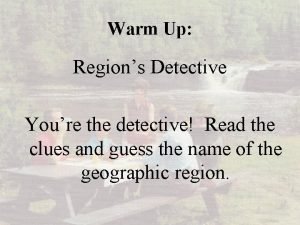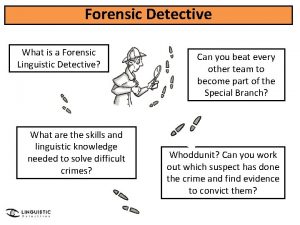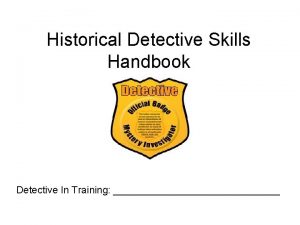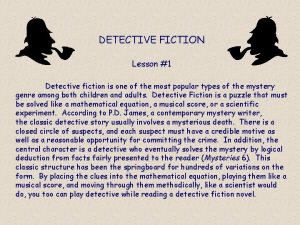Application of Criminological Theory to Terrorism Prevention Detective




















- Slides: 20

Application of Criminological Theory to Terrorism Prevention Detective Eric Paull Planning Research and Development Akron, OH Police Department

Criminological Theory Guides Applied Research and Practice in Law Enforcement For Local Law Enforcement, Terrorism Manifests Itself as Crime

Criminological Theory is an Interdisciplinary Science Pulling from Several Fields • • • Biology Anthropology Economics Psychology Sociology – Dominant since the 1920 s

Broken into Three Distinct Tracts • Social Process • Social Reaction • Social Structure- Some promising research derives from this perspective. . . but, politically unpopular since 1970 s due to a focus on determinism.

Social Structure is looked at from two distinct perspectives • Socio-economics – looks at individuals place in socio-economic strata as primary indicator of criminal activity (Behavior determined by SES). • Ecology – looks specifically at how geographic environment contributes to criminality (behavior determined by geography).

Criminological Theory is also broken down into two schools of thought • Classical School – focus on attributes of the criminal event. Views offenders as rational. • Positive School – focus on the individual. Views offender behavior as socially determined.

• Currently much theory focuses on the social determinants or “root causes” of criminal behavior. • Difficult for local law enforcement to influence • Criminology has recently seen a rise in the popularity of theories that look at criminogenic places rather than people (Note: People are seen as rational actors within the context of place).

Environmental Criminology “the focus of environmental criminology is the study of crime, criminality and victimization as they relate first to particular places and secondly to the way that individuals and organizations shape their activities spatially and in doing so are in turn influenced by place-based or spatial factors” Brantingham & Brantingham

Environmental Criminology Theories to Reduce Terrorism • Routine Activities Theory • Rational Choice Theory • Opportunity Theory

Environmental Criminology's Current Influence • • • Community Oriented Policing Problem Oriented Policing Intelligence Led Policing Crime Analysis Crime Prevention Through Environmental Design (CPTED)

ROUTINE ACTIVITIES THEORY “Routine Activity Theory” provides a simple and powerful insight into the causes of crime problems. At its heart is the idea that in the absence of effective controls, offenders will prey upon attractive targets. To have a crime, a motivated offender must come to the same place as an attractive target. For property crimes the target is a thing or an object. For personal crimes the target is a person. If an attractive target is never in the same place as a motivate offender, the target will not be taken, damaged, or assaulted. Also, there are controllers whose presence can prevent crime. If the controllers are absent, or present but powerlessness, crime is possible. Center for Problem Oriented Policing

ROUTINE ACTIVITIES THEORY CRIME TRIANGLE

ROUTINE ACTIVITIES THEORY • A suitable target must exist for a terrorist attack to occur • Strategies that increase guardianship and harden targets are achievable for local law enforcement and government • Routine Activities Theory can be used to inform such a strategy

Determine Target Suitability • • Value – what is the payoff Inertia – size or weight of an object Visibility – how highly visible is the target Access – how easy is the target to access

Increase Capable Guardians • • • Police Patrols Security Guards Neighborhood Watch Groups Locks Fences Barriers Lighting Alarms Systems Closed Circuit Television

Rationale Choice Theory A rational choice perspective provides the basic rationale for defining place as important, since it suggests that offenders will select targets and define means to achieve their goals in a manner that can be explained. (Cornish and Clarke, 1986)

OPPORTUNITY THEORY AND SITUATIONAL CRIME PREVENTION • Opportunity theory differs from routine activity theory in that it looks at reducing opportunities to commit crime whereas routine activities theory gives us a way to analyze crime patterns • Situational Crime Prevention consists of the specific actions that police take to address crime problems in local environments.

OPPORTUNITY THEORY AND SITUATIONAL CRIME PREVENTION By assessing the opportunities that specific situations offer for crime, situational crime prevention has identified five main ways in which situations can be modified. • Increasing the effort the offender must make to carry out the crime. • Increasing the risks the offender must face in completing the crime. • Reducing the rewards or benefits the offender expects to obtain from the crime. • Removing excuses that offenders may use to “rationalize” or justify their actions. • Reducing or avoiding provocations that may tempt or incite offenders into criminal acts.

A Terrorism Prevention Strategy for a Local Police Department can be based on the principles found in these theories • Rational choice theory informs us that terrorist are motivated offenders but also can be influenced by manipulating opportunities and awards • By utilizing the framework presented by routine activities theory and the crime triangle, targets can be identified that terrorist are likely to attack which will be catastrophic to the community. In addition, it will assist in the identification of the possible guardians for these targets • Opportunity theory leads us to recognize that we do have control over the environment in which terrorists must operate and by using situational crime prevention tactics we can affect that environment

Five specific outcomes can be addressed for strategy development. They are: • • • Identify potential targets that will be catastrophic to the community and are likely to be attacked Decrease the value of the target to the terrorists Decrease the visibility of the targets Decrease access of to the targets Increase guardianship of the targets
 Primary prevention secondary prevention tertiary prevention
Primary prevention secondary prevention tertiary prevention Define criminal psychiatry
Define criminal psychiatry Terrorism definition
Terrorism definition Terrorism
Terrorism Terrorism
Terrorism Nato definition terrorism
Nato definition terrorism Arizona counter terrorism information center
Arizona counter terrorism information center Fighting terrorism
Fighting terrorism Kansas eviction prevention program 2021
Kansas eviction prevention program 2021 Tzvetan todorov the typology of detective fiction summary
Tzvetan todorov the typology of detective fiction summary The no 1 ladies detective agency summary
The no 1 ladies detective agency summary Who created the fictional detective sherlock holmes
Who created the fictional detective sherlock holmes The detective need more time to inquire about the case.
The detective need more time to inquire about the case. Hard boiled detective characteristics
Hard boiled detective characteristics Detective draw
Detective draw Icat detective
Icat detective Semejanzas entre un detective y un periodista
Semejanzas entre un detective y un periodista Diction detective
Diction detective Language detective
Language detective What is a medical detective
What is a medical detective What is a medical detective
What is a medical detective


